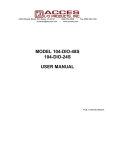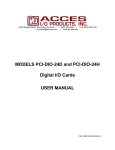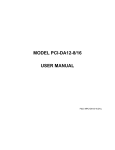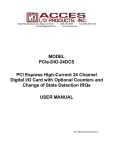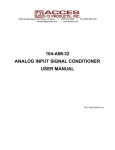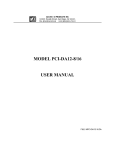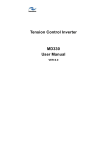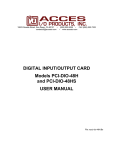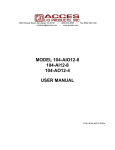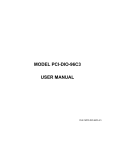Download MODEL 104-DIO-48E and 104-DIO
Transcript
10623 Roselle Street, San Diego, CA 92121 y (858) 550-9559 y Fax (858) 550-7322 [email protected] y www.accesio.com MODEL 104-DIO-48E and 104-DIO-24E USER MANUAL FILE: M104-DIO-48E.A1n Notice The information in this document is provided for reference only. ACCES does not assume any liability arising out of the application or use of the information or products described herein. This document may contain or reference information and products protected by copyrights or patents and does not convey any license under the patent rights of ACCES, nor the rights of others. IBM PC, PC/XT, and PC/AT are registered trademarks of the International Business Machines Corporation. Printed in USA. Copyright 2001, 2005 by ACCES I/O Products, Inc. 10623 Roselle Street, San Diego, CA 92121. All rights reserved. WARNING!! ALWAYS CONNECT AND DISCONNECT YOUR FIELD CABLING WITH THE COMPUTER POWER OFF. ALWAYS TURN COMPUTER POWER OFF BEFORE INSTALLING A BOARD. CONNECTING AND DISCONNECTING CABLES, OR INSTALLING BOARDS INTO A SYSTEM WITH THE COMPUTER OR FIELD POWER ON MAY CAUSE DAMAGE TO THE I/O BOARD AND WILL VOID ALL WARRANTIES, IMPLIED OR EXPRESSED. 2 Manual 104-DIO-48E, 24E Warranty Prior to shipment, ACCES equipment is thoroughly inspected and tested to applicable specifications. However, should equipment failure occur, ACCES assures its customers that prompt service and support will be available. All equipment originally manufactured by ACCES which is found to be defective will be repaired or replaced subject to the following considerations. Terms and Conditions If a unit is suspected of failure, contact ACCES' Customer Service department. Be prepared to give the unit model number, serial number, and a description of the failure symptom(s). We may suggest some simple tests to confirm the failure. We will assign a Return Material Authorization (RMA) number which must appear on the outer label of the return package. All units/components should be properly packed for handling and returned with freight prepaid to the ACCES designated Service Center, and will be returned to the customer's/user's site freight prepaid and invoiced. Coverage First Three Years: Returned unit/part will be repaired and/or replaced at ACCES option with no charge for labor or parts not excluded by warranty. Warranty commences with equipment shipment. Following Years: Throughout your equipment's lifetime, ACCES stands ready to provide on-site or in-plant service at reasonable rates similar to those of other manufacturers in the industry. Equipment Not Manufactured by ACCES Equipment provided but not manufactured by ACCES is warranted and will be repaired according to the terms and conditions of the respective equipment manufacturer's warranty. General Under this Warranty, liability of ACCES is limited to replacing, repairing or issuing credit (at ACCES discretion) for any products which are proved to be defective during the warranty period. In no case is ACCES liable for consequential or special damage arriving from use or misuse of our product. The customer is responsible for all charges caused by modifications or additions to ACCES equipment not approved in writing by ACCES or, if in ACCES opinion the equipment has been subjected to abnormal use. "Abnormal use" for purposes of this warranty is defined as any use to which the equipment is exposed other than that use specified or intended as evidenced by purchase or sales representation. Other than the above, no other warranty, expressed or implied, shall apply to any and all such equipment furnished or sold by ACCES. 3 Manual 104-DIO-48E, 24E Table of Contents Chapter 1: Introduction .........................................................................................................5 Specification ..................................................................................................................................................... 6 Figure 1-1: Block Diagram ............................................................................................................................ 7 Chapter 2: Installation ...........................................................................................................8 Figure 2-1: PC/104 Key Information ............................................................................................................. 9 Chapter 3: Option Selection ...............................................................................................10 Figure 3-1: Option Selection Map ............................................................................................................... 11 Chapter 4: Address Selection.............................................................................................12 Table 4-1: Standard Address Assignments for Computers......................................................................... 12 Table 4-2: Base Address Table................................................................................................................... 13 Chapter 5: Programming.....................................................................................................15 Developing Your Application Software........................................................................................................ 15 Table 5-1: Address Selection Table ............................................................................................................ 15 Digital I/O......................................................................................................................................................... 16 Table 5-2: Control Register Bit Assignment ................................................................................................ 16 Programming Example (Basic) ..................................................................................................................... 18 Enabling/ Disabling I/O Buffers .................................................................................................................... 18 Counter/Timer................................................................................................................................................. 19 Sharing Interrupts on the ISA Bus ............................................................................................................... 20 Chapter 6: 8254 Counter/Timer ..........................................................................................21 Operational Modes ......................................................................................................................................... 21 Reading and Loading the Counters ............................................................................................................. 23 8254 Driver ...................................................................................................................................................... 25 Enabling the Counter/Timer .......................................................................................................................... 26 Chapter 7: Connector Pin Assignments ............................................................................27 Table 7-1: Digital I/O (P3 and P4) Connector Pin Assignments ................................................................. 27 Table 7-2: Counter/Timer (82C54) Connector Pin Assignments ................................................................ 28 4 Manual 104-DIO-48E, 24E Chapter 1: Introduction Features • 48 Bits of Digital Input/Output. • Software Controlled Interrupt Generation. • All 48 I/O Lines are Buffered on the Board. • I/O Buffers Can Be Enabled/Disabled under Program Control. • Four and Eight Bit Ports Independently Selectable for I/O. • Pull-Ups on I/O Lines are standard, Pull-downs are an option. • +5V Supply Available to the User (fused, resettable). • Compatible with Industry Standard I/O Racks like Gordos, Opto-22, Potter & Brumfield, etc. • Counter/Timer 82C54, 3x16 bit (optional). Applications • Automatic Test Systems. • Laboratory Automation. • Robotics. • Machine Control. • Security Systems, Energy Management. • Relay Monitoring and Control. • Parallel Data Transfer to PC. • Sensing Switch Closures or TTL, DTL, CMOS Logic. • Driving Indicator Lights or Recorders. Description This board was designed for industrial applications and can be installed in a 16 bit or 8 bit PC/104 bus socket. Each I/O line is buffered and capable of sourcing 32mA or sinking 64mA. The board contains two Programmable Peripheral Interface (PPI) chips of type 82C55 to provide a computer interface to 48 I/O lines. There are three 8 bit ports: A, B, and C per PPI. Each 8 bit port can be configured by software to function as either inputs or latched outputs. Port C can also be configured as four inputs and four outputs. Pull-ups on the board assure that there are no erroneous outputs at power up. Pull-downs for any port can be installed at the factory on request. Also, bit C3 at each 24-bit Group can be used as an external interrupt to the computer. When bit C3 goes high (edge triggering), an interrupt may be requested. Interrupts from the ports are OR'ed together. Interrupts are directed to levels #3 through #7 and #10 through #12 by jumper installation. Jumpers allow interrupts from Port C bit 3 (either or both Groups) always, never, or controlled by Port C bit 7. Tristate I/O line buffers (74LS245) are configured automatically by hardware logic for input or output according to direction assignment written to the control register in the PPI. Further, a jumper on the board allows the tristate buffers to be enabled or disabled under program control. (See the Option Selection section to follow.) 5 Manual 104-DIO-48E, 24E I/O wiring connections are via 50-pin headers on the board. Two flat ribbon cables connect the board to external devices. This provides compatibility with OPTO-22, Gordos, Potter & Brumfield, and all module mounting racks. Every second conductor of the flat cables is grounded to minimize crosstalk between signals. If needed for external circuits, +5 VDC power (resettable fuse) is available on pin 49 of each I/O connector. The board occupies sixteen bytes of I/O address space. The base address is selectable via jumpers anywhere within the range of 000-3F0 hex. An illustrated setup program is provided with the board. Interactive displays show locations and settings of jumpers to select the board address, interrupt levels, and interrupt enables. Also, samples in several programming languages are presented in the Software section of this manual and on the accompanying CD. The board optionally has an 82C54 Counter/Timer chip. This can be used for frequency measurement, frequency output, pulse width modulation, pulse width measurement, event count, etc. SPECIAL NOTE FOR PROGRAMMERS: The one language not recommended for programming interrupt service routines is any version of Visual BASIC. The recommended programming languages for IRQ based applications are Delphi, C++ Builder, or Visual C. Specification Digital Inputs (TTL Compatible) • Logic High: 2.0 to 5.0 VDC. • Logic Low: -0.5 to +0.8 VDC. • Input Load (Hi): 20 uA. • Input Load (Lo): -200 uA. Digital Outputs • Logic High: 2.5 VDC min., source 32 mA. • Logic Low: 0.5 VDC max., sink 64 mA. • Power Output: +5 VDC from computer bus (ext. 0.5A fast-blow fuse is recommended). • Power Required: +5 VDC at 50 mA typical (all outputs HIGH, depends on features installed) Optional Counter/Timers • Type: 82C54 programmable interval counters • Output Drive: 8mA. • Input Gate: TTL/CMOS compatible. • Clock Output: 1MHz crystal-controlled oscillator. • Active Count Edge: Negative edge. • Timer Range: 16 bits event counter, 32 bits rate generator. 6 Manual 104-DIO-48E, 24E Environmental • Operating Temperature: 0 °C to +70 °C (optional -40 °C to +85 °C). • Storage Temperature: -50 °C to +120 °C. • Humidity: up to 95% RH, non-condensing. ADDRESS DECODE AND BUS INTERFACE C O N N E C T O R PORT A PPI PORT B GROUP PORT C HI 0 PORT C LO COMPUTER I/O BUS I/O B U F F E R S DATA BUFFERS C O N N E C T O R PORT A IRQ LEVEL SELECT PPI PORT B GROUP PORT C HI 1 PORT C LO DI/O INTERRUPT INTERRUPT 1MHz XTAL ENABLE I G 16-BIT COUNTER 0 O COUNTER 0 CLOCK INPUT I G I G 16-BIT COUNTER 1 16-BIT COUNTER 2 O O COUNTER 1 GATE INPUT COUNTER 2 CLOCK OUTPUT Figure 1-1: Block Diagram 7 Manual 104-DIO-48E, 24E Chapter 2: Installation A printed Quick-Start Guide (QSG) is packed with the board for your convenience. If you’ve already performed the steps from the QSG, you may find this chapter to be redundant and may skip forward to begin developing your application. The software provided with this PC/104 Board is on CD and must be installed onto your hard disk prior to use. To do this, perform the following steps as appropriate for your operating system. Substitute the appropriate drive letter for your CD-ROM where you see d: in the examples below. CD Installation The following instructions assume the CD-ROM drive is drive “D”. Please substitute the appropriate drive letter for your system as necessary. DOS 1. Place the CD into your CD-ROM drive. 2. Type B- to change the active drive to the CD-ROM drive. 3. 4. Type GLQR?JJ- to run the install program. Follow the on-screen prompts to install the software for this board. WINDOWS 1. Place the CD into your CD-ROM drive. 2. The system should automatically run the install program. If the install program does not run promptly, click START | RUN and type BGLQR?JJ, click OK or press -. 3. Follow the on-screen prompts to install the software for this board. LINUX 1. Please refer to linux.htm on the CD-ROM for information on installing serial ports under linux. 8 Manual 104-DIO-48E, 24E Installing the Hardware Before installing the board, carefully read Chapter 3 and Chapter 4 of this manual and configure the board according to your requirements. The SETUP Program can be used to assist in configuring jumpers on the board. Be especially careful with Address Selection. If the addresses of two installed functions overlap, you will experience unpredictable computer behavior. To help avoid this problem, refer to the FINDBASE.EXE program installed from the CD. The setup program does not set the options on the board, these must be set by jumpers. To Install the Board 1. 2. 3. 4. 5. 6. 7. Install jumpers for selected options and base address according to your application requirements, as mentioned above. Remove power from the PC/104 stack. Assemble standoff hardware for stacking and securing the boards. Carefully plug the board onto the PC/104 connector on the CPU or onto the stack, ensuring proper alignment of the pins before completely seating the connectors together. Install I/O cables onto the board’s I/O connectors and proceed to secure the stack together or repeat steps 3-5 until all boards are installed using the selected mounting hardware. Check that all connections in your PC/104 stack are correct and secure then power up the system. Run one of the provided sample programs appropriate for your operating system that was installed from the CD to test and validate your installation. Figure 2-1: PC/104 Key Information 9 Manual 104-DIO-48E, 24E Chapter 3: Option Selection Refer to the setup programs provided with the board. Also, refer to the Block Diagram and the board when reading this section of the manual. There are seven jumpers that select the IRQ level, six jumpers that select the base address, two jumpers that control the interrupt signals from the two I/O groups, and one jumper that affects the I/O buffers’ output-enable (tristate) for both I/O groups. External interrupts are accepted on the I/O connector(s) at pin 9 (bit C3). The interrupt occurs on the rising edge of the signal. Interrupts are always enabled if the jumper is installed in the IEN position, enabled if Port C bit 7 is low and the jumper is in the INP position, or disabled if the jumper is off the posts. Interrupts are directed to levels #2 through #7 and #10 through #12 by jumpers installed at locations labeled IRQ2 through IRQ7 and IRQ10 through IRQ12. Interrupts are enabled by writing any value to base address + Bh and disabled by reading from that address. Once an interrupt has occured it must be cleared (by writing any value to base address + Fh) for the next interrupt to occur. A jumper must be installed in either the IEN or the INP position for the interrupt to function. The 74LS245 input/output buffers can be enabled or disabled under program control. When the jumper is in the BEN (Buffer Enable) position, the I/O buffers are always enabled. When the jumper is in the TST (Tristate) position, the enabled/disabled state is controlled by a register. (See the programming section of this manual for a description.) In either case, the buffers’ directions are automatically configured by hardware that snoops the PPI command byte. The Counter/Timer shares the same I/O space as the digital I/O Group 0. To ‘map in’ the Counter/Timer, write any value to base address + Dh. After programming the counters, read base address + Dh to ‘map out’ the counters and re-enable access to the DIO. This trick halves the I/O space required by the board. 10 Manual 104-DIO-48E, 24E P3 Pin 1 IRQ 3 IRQ 4 IRQ 5 IRQ 7 IRQ 10 IRQ 11 IRQ 12 BEN A4 A5 A6 A7 A8 A9 INP1 INP0 IEN1 IEN0 TST P1 Pin 1 P4 Pin 1 Figure 3-1: Option Selection Map 11 Manual 104-DIO-48E, 24E Chapter 4: Address Selection The board occupies 16 bytes of I/O space. The board base address can be selected anywhere within the I/O address range 000-3F0. If in doubt where to assign the base address, refer to the following tables and the FINDBASE program to find an available address for your system. HexRange Usage 000-00F DMA Controller 1 020-021 INT Controller 1, Master 040-043 Programmable Interrupt Timer 060-06F Keyboard Controller 070-07F Real Time Clock, NMI Mask 080-09F DMA Page Register 0A0-0BF INT Controller 2 0C0-0DF DMA Controller 2 0F0-0F1 Math Coprocessor 0F8-0FF Math Coprocessor 170-177 Fixed Disk #1 1F0-1F8 Fixed Disk #2 200-207 Game I/O 238-23B Bus Mouse 23C-23F Alt. Bus Mouse 278-27F Parallel Printer 2B0-2BF EGA 2C0-2CF EGA 2D0-2DF EGA 2E0-2E7 GPIB (AT) 2E8-2EF Serial Port 2F8-2FF Serial Port 300-30F Prototype Board 310-31F Prototype Board 320-32F Hard Disk (XT) 370-377 Floppy Controller #2 378-37F Parallel Printer Port 1 380-38F SDLC 3A0-3AF SDLC 3B0-3BB Monochrome Display/Printer 3BC-3BF Parallel Printer Port 2 3C0-3CF VGA EGA 3D0-3DF CGA 3E8-3EF Serial Port 3F0-3F7 Floppy Diskette Controller 3F8-3FF Serial Port Table 4-1: Standard Address Assignments for Computers To set desired board address, refer to the illustrated Board Address setup program on the CD provided with the board. Type the desired address in hexadecimal code and the graphic display shows you how to set the Address Setup jumpers. These jumpers are marked A4-A9 and form a binary representation of the address in negative-true logic. (assign '0' to all Address Setup jumpers placed ON the posts, and assign '1' to all Address Setup jumpers left OFF.) 12 Manual 104-DIO-48E, 24E A9 A8 A7 A6 A5 A4 Address Range 3F0h - 3FFh On On On 3E0h - 3EFh 3D0h - 3DFh On On 3C0h - 3CFh 3B0h - 3BFh On On On On On On 3A0h - 3AFh 390h - 39Fh On On 380h - 38Fh 370h - 37Fh On On On On On On On On On On On On On On On On 360h - 36Fh 350h - 35Fh On 340h - 34Fh 330h - 33Fh On 320h - 32Fh 310h - 31Fh On On 300h - 30Fh 2F0h - 2FFh On On On On On On On On On On On On On On On On 2E0h - 2EFh 2D0h - 2DFh On 2C0h - 2CFh 2B0h - 2BFh On On On On On On On On On On On On On On On On On On On On On On On On On 2A0h - 2AFh 290h - 29Fh On 280h - 28Fh 270h - 27Fh On 260h - 26Fh 250h - 25Fh On 240h - 24Fh 230h - 23Fh On 220h - 22Fh 210h - 21Fh On 200h - 20Fh Table 4-2: Base Address Table To set the base address of the board, install the jumpers “ON” the posts for that address according to the table. 13 Manual 104-DIO-48E, 24E Caution Carefully review the address selection reference table on the previous page before selecting the board address. If the addresses of two circuits overlap you will experience unpredictable computer behavior. Note that address ranges 100h-10Fh through 1F0h-1FFh can be selected with the jumpers for A8 off and A9 on. 14 Manual 104-DIO-48E, 24E Chapter 5: Programming The board is an I/O-mapped device that is easily configured from any language and any language can easily perform digital I/O through the board's ports. This is especially true if the form of the data is byte or word wide. All references to the I/O ports would be in absolute port addressing. However, a table could be used to convert the byte or word data ports to a logical reference. The recommended languages to program in to write interrupt service routines in are Delphi and C++ Builder. Visual C is more difficult to accomplish this in and Visual BASIC is NOT recommended for interrupt type programming. Developing Your Application Software Address Register Operation (Counter/Timer Disabled) (Counter/Timer Enabled) Base Address PA Group 0 Counter/Timer 0 Read/Write Base Address +1 PB Group 0 Counter/Timer 1 Read/Write Base Address +2 PC Group 0 Counter/Timer 2 Read Write Base Address +3 Control Group 0 Counter/Timer Control Write Only Base Address +4 PA Group 1 Read/Write Base Address +5 PB Group 1 Read/Write Base Address +6 PC Group 1 Read/Write Base Address +7 Control Group 1 Write Only Base Address +8 Enable/Disable Buffer, Grp 0 Write Only Base Address +9 Enable/Disable Buffer, Grp 1 Write Only Base Address +A Base Address +B Enable Interrupt Write Base Address +B Disable Interrupt Read Base Address +D Enable Counter/Timer Addressing Write Base Address +D Disable Counter/Timer Addressing Read Base Address +C Base Address +E Base Address +F Clear Interrupt Read/Write Table 5-1: Address Selection Table 15 Manual 104-DIO-48E, 24E Digital I/O Please refer to the data sheets and 8255-5 specification in the ‘Chip Docs’ directory on the CD. The board uses two 8255-5 PPIs to provide a total of 48 bits input/output. The board is designed to use each of these PPIs in Mode 0 wherein for each group: a. b. c. d. There are two 8-bit ports (A and B) and two 4-bit ports (C Hi and C Lo). Any port can be configured as an input or an output. Outputs are latched. Inputs are not latched. Each PPI contains a Control Register. This write-only, 8-bit register is used to set the mode and direction of the ports. At Power-Up or Reset, all I/O lines are set as inputs. Each PPI should be configured during initialization by writing to the Control Registers even if the ports are only going to be used as inputs. Output buffers are automatically set by hardware according to the Control Register states. Note that Control Registers are located at base address +3 and base address +7. Bit assignments in each of these Control Registers are as follows: Bit Assignment Code Port C Lo (C0-C3) 1=Input, 0=Output D1 Port B 1=Input, 0=Output D2 Mode Select 1=Mode 1, 0=Mode 0 D3 Port C Hi (C4-C7) 1=Input, 0=Output D4 Port A 1=Input, 0=Output Mode Select 00=Mode 0, 01=Mode 1, 1X=Mode 2 Mode Set Flag 1=Active D0 Bit D5, D6 D7 Table 5-2: Control Register Bit Assignment Note Mode 1 and Mode 2 cannot be used by the board without modification (Consult the factory.). Thus, bits D2, D5, and D6 should always be set to "0" and, when the TST/BEN jumper is in the BEN position, Bit D7 to "1". The hardware will reject any command in which bits D2, D5, and D6 aren’t zero. Note In Mode 0, do not use the control register byte for the individual bit control feature. The hardware uses the I/O bits to control buffer direction on this board. The control register should only be used for setting up input and output of the ports and enabling the buffer. The board is initialized in the receive mode by the computer reset command. a. When bit D7 of the Control Register is set high, direction of the three ports of the associated PPI chip as well as the mode can be set. For example, a write to Base Address +3 with data bit D7 high programs port direction at Group 0 ports A, B, and C. If, for example, hex 80 is sent to Base Address +3, the Group 0 PPI will be configured in mode 0 with Ports A, B, and C as outputs. 16 Manual 104-DIO-48E, 24E b. At the same time, data bit D7 is also latched in a buffer controller for the associated PPI chip. A high state disables the buffers and, thus, all four buffers will be put in the tristate mode; i.e. disabled. c. Now, if any of the ports are to be set as outputs, you may set the values to the respective port with the outputs still in the tristate condition. (If all ports are to be set as inputs, this step is not necessary.) d. If data bit D7 is low when the control byte is written, ONLY the associated buffer controller is addressed. If, for example, a control byte of hex 80 has been sent as previously described, and the data to be output are correct, and it is now desired to open the three ports, then it is necessary to send a control byte of hex 00 to base address +3 to enable the Group 0 buffers. When you do this, the buffers will be enabled. Note: All data bits except D7 must be the same for the two control bytes. Those buffers will now remain enabled until another control byte with data bit D7 high is sent to base address +3. The buffers for all ports of the group can be tri-stated without changing the PPI configuration by writing to base address +8 with D7 LOW. Similarly, the Group 1 ports can be enabled/disabled via the control register at base address +7. The following program fragment in C language illustrates the foregoing: const BASE_ADDRESS 0x300; outportb(BASE_ADDRESS +3, 0x89); outportb(BASE_ADDRESS,0); outportb(BASE_ADDRESS+1,0); outportb(BASE_ADDRESS +3, 0x09); /*This instruction sets the mode to Mode 0, ports A and B as output, and port C as input. Since bit D7 is high, the output buffers are set to tristate condition. See item b. above.*/ /*These instructions set the initial state of ports A and B to all zeroes. Port C is not set because it is configured as an input. See item c. above.*/ /*Enable the tristate output buffers by using the same control byte used to configure the PPI, but now set bit D7 low. See item d. above.*/ 17 Manual 104-DIO-48E, 24E Programming Example (Basic) The following example in BASIC is provided as a guide to assist you in developing your working software. In this example, the board base address is 2D0 hex and the I/O lines of group 0 are to be setup as follows: Port A = Input Port B = Output Port C Hi = Input Port C Lo = Output The first step is to configure the control register. Configure bits of the control register as: D7 1 Active Mode Set D6 0 Mode 0 D5 0 Mode 0 D4 1 Port A = Input D3 1 Port C Hi = Input D2 0 Mode 0 D1 0 Port B = Output D0 0 Port C Lo = Output This corresponds to 98 hex. If the board address is 2D0 hex, use the BASIC OUT command to write to the control register as follows: 10 20 BASEADDR=&H2D0 OUT BASEADDR+3,&H98 To read the inputs at Port A and the upper nybble of Port C: 30 40 X=INP(BASEADDR) Y=INP(BASEADDR+2)/16 ‘Read Port A 'Read Port C Hi To set outputs high (1) at Port B and the lower nybble of Port C: 50 OUT BASEADDR+1,&HFF 'Turn on all Port B bits 60 OUT BASEADDR+2,&HF ‘Turn on all bits of Port C lower nybble Enabling/ Disabling I/O Buffers When using the tristate mode (Jumper in the TST position), the method to disable the I/O buffers involved writing a control word to the Control Register at Base Address +3 and Base Address +7. This control word was required to have bit D7 (the most significant bit) set. That meant that the PPI translated it as an "active mode set" and reset the output data latches to "zero" on all output ports and the output buffers were disabled. However, if the buffers are to be enabled at a later time, the output latches will be in a "zero" state. For example, if all the outputs were 1's, they will now be 0's and the output buffers will be disabled. This problem can be resolved as follows. 18 Manual 104-DIO-48E, 24E Two computer I/O bus addresses are available that permit you to enable or disable the I/O buffers at will, without programming the PPI mode. Buffers for Goup 0 bits are enabled/disabled at Base Address +8 and buffers for Group 1 bits are enabled/disabled at Base Address +9. To enable the buffers and to set outputs to the desired state, you can write to the Control Register with bit D7 low. If you wish to subsequently disable the buffers, you can write to the Control Register with bit D7 high. In this way you can enable/disable the output buffers without programming the PPI mode. Note When writing a command byte to the board while the TST jumper is installed, the PPI output buffers are disabled. Thus, when you desire to change the mode, you must first set the new mode and then enable the buffers. Enabling the buffers can be done at either Base Address +3 (or +7) or Base Address +8 (or +9). Counter/Timer The board uses an 8254 counter/timer chip to provide three counter/timers. In order to save space, the counter/timers use the same addresses as PPI 0 (Base Address + 0h to Base Address + 3h). To “map in the counter/timer (and “map out” PPI 0), write any value to Base Address + Dh. To “map out” the counter/timer (and “map in” PPI 0), read from Base Address + Dh. This mapping does not reset either chip in any way, so you can (for example) map in the counter/timer, set it to generate a particular frequency, then map it out and use PPI 0 while the counter/timer continues to generate the frequency. The counter/timer has a variety of uses: event counting, frequency measurement, frequency generation. See the 8254 Counter/Timer chapter for details on how to use it. 19 Manual 104-DIO-48E, 24E Sharing Interrupts on the ISA Bus On occasion a system application will require more interrupt levels than are available on the ISA bus. While this is not recommended, IRQ sharing is possible. Each board that is going to share an IRQ must strictly adhere to a special standard for accessing the IRQ lines as follows: 1. 2. 3. The interrupt must be held in a high impedance state until asserting an interrupt. The interrupt must be asserted in the form of a low signal lasting at least 500 nanoseconds followed by a rising edge and then immediately returning to a high impedance condition. The board must contain a status register or flag of some kind to indicate that it generated the interrupt. There is an exception to this rule. This is the case where only one board (of those sharing the interrupt level) does not provide a status bit to indicate that it asserted the interrupt but is otherwise capable of sharing the IRQ. In this case, it may share the interrupt level with other boards if (a) it is the only board on that IRQ level that does not have a status bit and (b) it is installed onto the IRQ vector first. (This makes it the last board to be called in the vector chain.) This scheme will work because it can be assumed that if every other board in the vector chain did not cause the interrupt, then the last board must be the one that did. Note If two boards assert the IRQ line within 500 nanoseconds of each other, the second board in the ISR chain will not be serviced. It is possible to alleviate this problem by writing a single ISR that can detect the bit flag on every board and therefore detect the fact that two boards (or more) report generating an interrupt even though only one interrupt was processed by the CPU. The interrupt driver circuit on the board will drive the selected IRQ line for approximately 500nS and then tristate. 20 Manual 104-DIO-48E, 24E Chapter 6: 8254 Counter/Timer These boards optionally contain one type 82C54 programmable counter/timer. This is hard wired on the board to allow you to implement a 16-bit Event Counter or 32-bit Rate Generator (Frequency Output) functions. See the block diagram. The 82C54 is a flexible and powerful device that consists of three independent 16-bit down counters. Each counter can be programmed to any count as low as 1 or 2 (depending on the mode chosen) and up to 65,535. For those interested in more detailed information, a full description can be found in the Intel (or equivalent manufacturer's) data sheet in the Chip Docs section on the CD. To save I/O space, the digital I/O registers overlay the Counter/Timer register space. To access these registers, write any value to base address + Dh. After the Counter/Timer is programmed, read from the same address to regain access to the digital I/O circuit. Operational Modes The 8254 modes of operation are described in the following paragraphs to familiarize you with the versatility and power of this device. For those interested in more detailed information, a full description of the 8254 programmable interval timer can be found in the Intel (or equivalent manufacturers') data sheets. The following conventions apply for use in describing operation of the 8254 : Clock: Trigger: Counter Loading: A positive pulse into the counter's clock input A rising edge input to the counter's gate input Programming a binary count into the counter Mode 0: Pulse on Terminal Count After the counter is loaded, the output is set low and will remain low until the counter decrements to zero. The output then goes high and remains high until a new count is loaded into the counter. A trigger enables the counter to start decrementing. Mode 1: Retriggerable One-Shot The output goes low on the clock pulse following a trigger to begin the one-shot pulse and goes high when the counter reaches zero. Additional triggers result in reloading the count and starting the cycle over. If a trigger occurs before the counter decrements to zero, a new count is loaded. This forms a retriggerable one-shot. In mode 1, a low output pulse is provided with a period equal to the counter count-down time. Mode 2: Rate Generator This mode provides a divide-by-N capability where N is the count loaded into the counter. When triggered, the counter output goes low for one clock period after N counts, reloads the initial count, and the cycle starts over. This mode is periodic, the same sequence is repeated indefinitely until the gate input is brought low. This mode also works well as an alternative to mode 0 for event counting. Mode 3: Square Wave Generator This mode operates like mode 2. The output is high for half of the count and low for the other half. If the count is even, then the output is a symmetrical square wave. If the count is odd, then the output is high for (N+1)/2 counts and low for (N-1)/2 counts. Periodic triggering or frequency synthesis are two possible applications for this mode. Note that in this mode, to achieve the square wave, the counter decrements by two for the total loaded count, then reloads and decrements by two for the second part of the wave form. 21 Manual 104-DIO-48E, 24E Mode 4: Software Triggered Strobe This mode sets the output high and, when the count is loaded, the counter begins to count down. When the counter reaches zero, the output will go low for one input period. The counter must be reloaded to repeat the cycle. A low gate input will inhibit the counter. Mode 5: Hardware Triggered Strobe In this mode, the counter will start counting after the rising edge of the trigger input and will go low for one clock period when the terminal count is reached. The counter is retriggerable. The output will not go low until the full count after the rising edge of the trigger. Programming the 8254 The counters are programmed by writing a control byte into the counter control register. The control byte specifies the counter to be programmed, the counter mode, the type of read/write operation, and the modulus. The control byte format is as follows: B7 B6 B5 B4 B3 B2 B1 B0 SC1 SC0 RW1 RW0 M2 M1 M0 BCD SC0-SC1: These bits select the counter that the control byte is destined for. SC1 SC0 Function 0 0 Program Counter #0 0 1 Program Counter #1 1 0 Program Counter #2 1 1 Read/Write Cmd.* * See section on Reading and Loading the Counters. RW0-RW1: These bits select the read/write mode of the selected counter. RW1 RW0 Counter Read/Write Function 0 0 Counter Latch Command 0 1 Read/Write LS Byte 1 0 Read/Write MS Byte 1 1 Read/Write LS Byte, then MS Byte 22 Manual 104-DIO-48E, 24E M0-M2: BCD: These bits set the operational mode of the selected counter. Mode M2 M1 M0 0 0 0 0 1 0 0 1 2 X 1 0 3 X 1 1 4 1 0 0 5 1 0 1 Set the selected counter to count in binary (BCD = 0) or BCD (BCD = 1). Reading and Loading the Counters If you attempt to read the counters on the fly when there is a high input frequency, you will most likely get erroneous data. This is partly caused by carries rippling through the counter during the read operation. Also, the low and high bytes are read sequentially rather than simultaneously and, thus, it is possible that carries will be propagated from the low to the high byte during the read cycle. To circumvent these problems, you can perform a counter-latch operation in advance of the read cycle. To do this, load the RW1 and RW2 bits with zeroes. This instantly latches the count of the selected counter (selected via the SC1 and SC0 bits) in a 16-bit hold register. (An alternative method of latching counter(s) that has an additional advantage of operating simultaneously on several counters is through a readback command to be discussed later.) A subsequent read operation on the selected counter returns the held value. Latching is the best way to read a counter on the fly without disturbing the counting process. You can only rely on directly read counter data if the counting process is suspended while reading by bringing the gate low. For each counter you must specify in advance the type of read or write operation that you intend to perform. You have a choice of loading/reading (a) the high byte of the count, or (b) the low byte of the count, or (c) the low byte followed by the high byte. This last is most generally used and is selected for each counter by setting the RW1 and RW0 bits to ones. Subsequent read/load operations must be performed in pairs in this sequence or the sequencing flip-flop in the 8254 chip will get out of step. The readback command byte format is: CNT: STA: C0, C1, C2: B7 B6 B5 B4 B3 B2 B1 B0 1 1 CNT STA C2 C1 C0 0 When 0, latches the counters selected by bits C0-C2. When 0, returns the status byte of counters selected by C0-C2. When high, select a particular counter for readback. C0 selects Counter 0, C1 selects Counter 1, and C2 selects Counter 2. You can perform two types of operations with the readback command. When CNT=0, the counters selected by C2 through C0 are latched simultaneously. When STA=0, the counter status byte is read when the counter I/O location is accessed. The counter status byte provides information about the current output state of the selected counter and its configuration. 23 Manual 104-DIO-48E, 24E The status byte returned if STA=0 is: OUT: NC: RW1, RW0: M2, M1, M0: BCD: B7 B6 B5 B4 B3 B2 B1 B0 OUT NC RW1 RW2 M2 M1 M0 BCD Current state of counter output pin. Null count. This indicates when the last count loaded into the counter register has been loaded into the actual counter. The exact time of load depends on the configuration selected. Until the count is loaded into the counter, it cannot be read. Read/Write command. Counter mode. BCD = 0 is binary mode, otherwise counter is in BCD mode. If both STA and CNT bits in the readback command byte are set low and the RW1 and RW0 bits have both been previously set high in the counter control register (thus selecting two-byte reads), then reading a selected counter address location will yield: 1st Read: 2nd Read: 3rd Read: Status byte Low byte of latched data High byte of latched data After any latching operation on a counter, the contents of its hold register must be read before any subsequent latches of that counter will have any effect. If a status latch command is issued before the hold register is read, then the first read will read the status, not the latched value. 24 Manual 104-DIO-48E, 24E 8254 Driver A simple driver is provided to perform basic counter/timer operations on this board. Source code for the driver and a sample program showing how to use the functions are located in the DOS\CSAMPLES directory. The following functions are provided: Frequency Measure The Frequency Measure function of the 8254 Counter Driver has the ability to measure an unknown frequency from 1KHz to 2MHz. This function requires as input the Base Address of the board. The unknown frequency is applied to the CLOCK IN pin of the board (P1 pin 5). The function will return the frequency as a long integer in Hz. long frequency_measure(unsigned BaseAddress); Event Counter The Event Counter function has the ability to trace the number of events that have occurred. This function requires the Base Address and an additional parameter that identifies which features should be implemented on this call to the function. Each feature can be identified by its unique integer value. Multiple features can be run in a single call to the function by ORing the respective integer values together. Features will be executed in increasing integer order. The CLOCK IN pin of the board (P1 pin 5) is the point of application for the incoming events. (Note: This function is limited by the input speed of the 8254 counter, and slow signals are preferred. Further only 65,535 events are possible without a RESET.) The function returns the number of events (based on priority) or 0 for those features that do not specify a return value. Features: INITIALIZE START SINCESTART SINCELAST STOP RESET = 1; = 2; = 4; = 8; = 16; = 32; initialize the counter begin counting return the number of events since the start return the number of events since last check stop counting events reset number of events to 0 unsigned event_counter(unsigned BaseAddress, int feature); Generate Frequency The Generate Frequency function will generate a square wave (0 to +5V) with the desired frequency. The Base Address of the board as well as the frequency are required as input to the function. The counter can generate a frequency with a range of 1Hz to 250KHz. The square wave can be read on the CLOCK OUT pin of the board (P1 pin 9). void generatefrequency(unsigned BaseAddress, unsigned long frequency); Pulse Width The Pulse Width function will measure the width of an applied event from its rise to its fall (effectively one half the period). The Base Address of the board is required as input to the function. The signal should be applied to the GATE IN pin of the board (P1 pin 7). Software latency will be affected by the operating system and will set a limit on the precision of the measurement. unsigned pulse_width(unsigned BaseAddress); 25 Manual 104-DIO-48E, 24E Enabling the Counter/Timer In order to save space, the counter/timers use the same addresses as PPI 0 (Base Address + 0h to Base Address + 3h). To “map in the counter/timer (and “map out” PPI 0), write any value to Base Address + Dh. To “map out” the counter/timer (and “map in” PPI 0), read from Base Address + Dh. This mapping does not reset either chip in any way, so you can (for example) map in the counter/timer, set it to generate a particular frequency, then map it out and use PPI 0 while the counter/timer continues to generate the frequency. 26 Manual 104-DIO-48E, 24E Chapter 7: Connector Pin Assignments Two 50-pin headers are provided on the board; one for each 24 I/O group. PPI Group 0 is on connector P3, and PPI Group 1 is on connector P4. The mating connector is an AMP type 1-746285-0 or equivalent. Connector pin assignments are listed below. Notice that every second line is grounded to minimize crosstalk between signals. Table 7-1: Digital I/O (P3 and P4) Connector Pin Assignments Assignment Pin Assignment Pin PC7 1 2 PC6 3 4 PC5 5 6 PC4 7 8 PC3 9 10 PC2 11 12 PC1 13 14 PC0 15 16 PB7 17 18 PB6 19 20 PB5 21 22 PB4 23 PB3 25 PB2 27 28 PB1 29 30 PB0 31 32 PA7 33 34 PA6 35 36 PA5 37 38 PA4 39 40 PA3 41 42 PA2 43 44 PA1 45 46 PA0 47 48 49 50 Port C Hi Port C Lo Port B Port A +5 VDC All Even Numbered Pins are GROUND 27 24 26 Manual 104-DIO-48E, 24E Table 7-2: Counter/Timer (82C54) Connector Pin Assignments Assignment Pin Ground 1 Ground 2 1MHz Clock output 3 Ground 4 Clock 0 a.k.a. CLOCK IN (events) input 5 Ground 6 Gate 1 a.k.a. GATE IN input 7 Ground 8 Output 2 a.k.a. CLOCK OUT 9 Ground 10 28 Manual 104-DIO-48E, 24E Customer Comments If you experience any problems with this manual or just want to give us some feedback, please email us at: [email protected]. Please detail any errors you find and include your mailing address so that we can send you any manual updates. 10623 Roselle Street, San Diego CA 92121 Tel. (858)550-9559 FAX (858)550-7322 www.accesio.com 29 Manual 104-DIO-48E, 24E





























